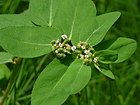Note: This is a project under development. The articles on this wiki are just being initiated and broadly incomplete. You can Help creating new pages.
Difference between revisions of "Euphorbia hypericifolia"
(→Identification) |
(→Identification) |
||
| Line 40: | Line 40: | ||
===Fruit=== | ===Fruit=== | ||
| − | {{Fruit | + | {{Fruit||||||Fruiting season is June - November}} |
===Other features=== | ===Other features=== | ||
Revision as of 11:52, 10 August 2021
Euphorbia hypericifolia is an annual or perennial plant with spreading or erect branches. It can grow up to 60cm tall. The plant is commonly used in many parts of the world in the treatment of a wide variety of gastro-intestinal disorders. It is widely traded in the United States, in both tablet and powder form, mainly to treat bowel disorders. It is also traded internationally through the internet.
Contents
- 1 Uses
- 2 Parts Used
- 3 Chemical Composition
- 4 Common names
- 5 Properties
- 6 Habit
- 7 Identification
- 8 List of Ayurvedic medicine in which the herb is used
- 9 Where to get the saplings
- 10 Mode of Propagation
- 11 How to plant/cultivate
- 12 Commonly seen growing in areas
- 13 Photo Gallery
- 14 References
- 15 External Links
Uses
Gonorrhoea, Menorrhagia, Leucorrhoea, Pneumonia, Bronchitis, Cuts, Wounds, Headache, Dysentery, Colic.[1]
Parts Used
Chemical Composition
Common names
| Language | Common name |
|---|---|
| Kannada | |
| Hindi | Dudhi |
| Malayalam | |
| Tamil | |
| Telugu | |
| Marathi | |
| Gujarathi | |
| Punjabi | |
| Kashmiri | |
| Sanskrit | Dugdika |
| English |
Properties
Reference: Dravya - Substance, Rasa - Taste, Guna - Qualities, Veerya - Potency, Vipaka - Post-digesion effect, Karma - Pharmacological activity, Prabhava - Therepeutics.
Dravya
Rasa
Guna
Veerya
Vipaka
Karma
Prabhava
Habit
Identification
Leaf
| Kind | Shape | Feature |
|---|---|---|
Flower
| Type | Size | Color and composition | Stamen | More information |
|---|---|---|---|---|
| Flowering season is June - November |
Fruit
| Type | Size | Mass | Appearance | Seeds | More information |
|---|---|---|---|---|---|
| Fruiting season is June - November |
Other features
List of Ayurvedic medicine in which the herb is used
Where to get the saplings
Mode of Propagation
How to plant/cultivate
Originally from tropical America, the plant has spread as a weed into many areas of the tropics.[4]
Commonly seen growing in areas
Along roadsides, Stony river sides, Waste places.
Photo Gallery
References
- ↑ Indian Medicinal Plants by C.P.Khare
- ↑ [Chemistry]
- ↑ [Morphology]
- ↑ Cultivation
External Links
- Ayurvedic Herbs known to be helpful to treat Gonorrhoea
- Ayurvedic Herbs known to be helpful to treat Menorrhagia
- Ayurvedic Herbs known to be helpful to treat Leucorrhoea
- Ayurvedic Herbs known to be helpful to treat Pneumonia
- Ayurvedic Herbs known to be helpful to treat Bronchitis
- Ayurvedic Herbs known to be helpful to treat Cuts
- Ayurvedic Herbs known to be helpful to treat Wounds
- Ayurvedic Herbs known to be helpful to treat Headache
- Ayurvedic Herbs known to be helpful to treat Dysentery
- Ayurvedic Herbs known to be helpful to treat Colic
- Herbs with Flowers used in medicine
- Herbs with common name in Hindi
- Herbs with common name in Sanskrit
- Habit - Perennial
- Index of Plants which can be propagated by Seeds
- Herbs that are commonly seen in the region of Along roadsides
- Herbs that are commonly seen in the region of Stony river sides
- Herbs that are commonly seen in the region of Waste places
- Herbs
- Pages without herbs images



